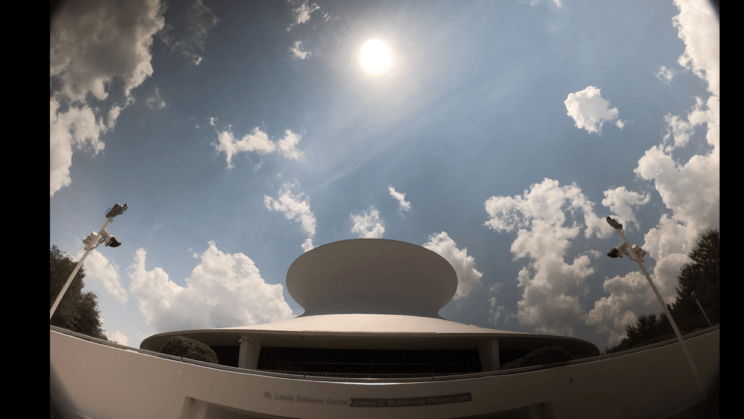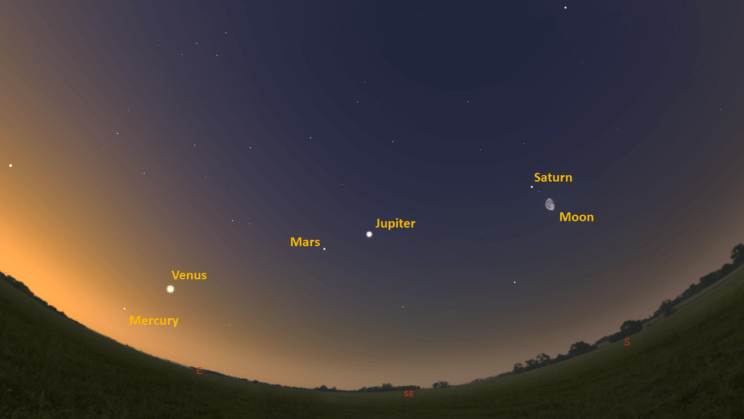This is the Saint Louis Science Center’s NIGHT SKY UPDATE for the week of Friday, June 17, 2022.
Information updated weekly or as needed.
Times given as local St. Louis time which is Central Daylight Time (CDT). For definitions of terminology used in the night sky update, click the highlighted text. If relying on times posted in Universal Time (UT), St. louis is -5 hours when CDT.
Public Telescope Viewings
Public telescope viewings at the McDonnell Planetarium have returned as part of the Saint Louis Science Center’s First Friday event. As we ease back into our telescope nights, they will operate a little different than before. To take part in our telescope viewings you will need to get a ticket for the planetarium show that starts at 7:00 p.m. as part of the First Friday event. Tickets for the First Friday planetarium show are free, but they can only be picked up at the Saint Louis Science Center on the night of the event. After the planetarium show ends you will be able to go outside and look through telescopes weather permitting. We will update this posting if anything changes.
Solar telescopes viewings have also returned and will take place every Sunday from 11:00 a.m. to 3:00 p.m. weather permitting. Solar Sundays will run from May 29, 2022, to September 4, 2022. The return of Solar Sundays is a good opportunity to prepare for the upcoming solar eclipses in 2023 and 2024.
Observing Highlight of the Week

The summer solstice Sun seen above the James S. McDonnell Planetarium. Image credit Eric Gustafson.
On Tuesday June 21, 2022, at 9:14 UT, the summer solstice for the northern hemisphere occurs. This marks the start of northern summer. Due to Earth’s axial tilt, the northern hemisphere will experience its longest day and shortest night. For stargazers we are looking at roughly 15 hours of daylight and another 4 hours of twilight, which leaves us only 5 hours of night to observe. Even with this short observing window, summer nights offer up some of the best views.
Astronomically speaking, the Sun will appear its highest in the sky for the year. The term solstice comes from Sol (Sun) and sticium (standstill). When we approach the summer solstice, the Sun appears to standstill regarding its max/min altitude at solar noon or the azimuth position of its rise and set points on the horizon. When considering where the Sun rises and sets, the standstill points are its most northerly and southernly extremes along the horizon. For most, this standstill behavior will be easier to note if you observe where the Sun rises or sets each day. Many of the worlds ancient observatories were used in this way. Stonehenge in England, the Oyu Stones in Japan and Woodhenge at Cahokia Mounds are a few great examples.
Observing the solstice and equinox points of the Sun is a long tradition found throughout the world. Long ago humanity developed an idea of cyclic time that was marked by the cosmic cycles of the Sun, Moon and other astronomical objects. The rebirth and growth of the changing world were connected to the cycles of the Moon and Sun. Our modern calendars are the product of the vast connection society has had with astronomy. Several annual traditions and celebrations observed each year are examples of these connections.
Day or night, this coming Tuesday there are several reasons to get out and observe. I would encourage all to note how the Sun’s position changes through the day. Make note of the length of shadows at local noon. Do the same on the winter solstice and the spring and fall equinox. In doing this, we get a taste of the knowledge that was discovered thousands of year ago that helped guide humanity to where we find it today.
The Sun and Moon

The Moon as seen from the International Space Station, on July 31, 2011.
Credit: NASA
Sunrise is at 5:36 a.m. on Friday, June 17 and sunset is at 8:28 p.m. providing us with roughly 15 hours of daylight. Even after sunset, the light from the Sun will dimly illuminate our sky for roughly 2 hours. This period is called twilight, which ends around 10:26 p.m. this week. For those with a sundial, local noon occurs around 1:01 p.m. this week.
| Day | Sunrise | Sunset |
|---|---|---|
| 2022-06-17 | 5:36 a.m. | 8:28 p.m. |
| 2022-06-18 | 5:36 a.m. | 8:28 p.m. |
| 2022-06-19 | 5:36 a.m. | 8:28 p.m. |
| 2022-06-20 | 5:36 a.m. | 8:28 p.m. |
| 2022-06-21 | 5:36 a.m. | 8:29 p.m. |
| 2022-06-22 | 5:37 a.m. | 8:29 p.m. |
| 2022-06-23 | 5:37 a.m. | 8:29 p.m. |
| 2022-06-24 | 5:37 a.m. | 8:29 p.m. |
| 2022-06-25 | 5:38 a.m. | 8:29 p.m. |
Moon
Moonrise for Friday, June 17 occurs at 11:57 p.m. and moonset will occur at 10:10 a.m. on the following morning. On Friday, June 17, the Moon will exhibit a waning gibbous phase with 85% of the lunar disk illuminated. Last quarter moon occurs on June 20, 2022, at 10:11 p.m.
International Space Station (ISS) Observing

Visible passes of ISS from St. Louis for the week of June 17 occur during morning hours. The best pass this week occurs on the morning of June 24. Use the table below for information about this and other visible passes this week.
Catch ISS from St. Louis starting Friday, June 17
| Date | Starts | Max. altitude | Ends | |||||||
|---|---|---|---|---|---|---|---|---|---|---|
| Time | Alt. | Az. | Time | Alt. | Az. | Time | Alt. | Az. | ||
| 22 Jun | -1.1 | 04:52:42 | 10 | SSE | 04:54:10 | 12 | SE | 04:55:38 | 10 | ESE |
| 24 Jun | -2.6 | 04:50:28 | 10 | SSW | 04:53:35 | 36 | SE | 04:56:43 | 10 | ENE |
| 25 Jun | -1.8 | 04:03:46 | 16 | SSE | 04:05:11 | 20 | SE | 04:07:44 | 10 | E |
Magnitude (Mag): The Measure of brightness for a celestial object. The lower the value is, the brighter the object will be.
Altitude (Alt): The angle of a celestial object measured upwards from the observer’s horizon.
Azimuth (Az): The direction of a celestial object, measured clockwise from an observer’s location with north being 0°, east being 90°, south being 180° and west being 270°.
For information about ISS flyovers and other visible satellites, visit www.heavens-above.com
Detailed information regarding all unmanned exploration of our universe, missions past, present, and planned, can be found at Jet Propulsion Laboratories:
The Visible Planets

Looking southeast at 5:00 a.m. June 17, 2022. Credit: Stellarium, EG
This week, five naked eye planets are visible. Venus, Mars, Jupiter and Saturn are seen in the east and southeast before sunrise. Mercury is joining the other four but it is still low to the east before sunrise.
Mercury
Mercury has started its next morning apparition. It is still and difficult to spot, but it is joining the other naked eye planets in the morning sky. Look for it about 6.5° above the eastern horizon around 5:00 a.m.
Venus
Venus has started a morning apparition and will be seen in the southeast before sunrise. Venus rises at 3:47 a.m. and should be easy to spot in the southeast by 4:45 a.m. The current morning apparition lasts until the third week of October 2022. Venus reaches superior conjunction on October 22, 2022.
Mars
Mars rises at 2:06 a.m. Start looking for the red planet around 3:00 a.m. as it clears trees and buildings. Mars will continue to climb out of the Sun’s glare as it heads towards opposition later this year on December 7, 2022.
Jupiter
Jupiter rises at 1:35 a.m. and should be visible by 2:30 a.m. As the year goes on, Jupiter will rise about 25 minutes earlier than it did the week before. Jupiter will reach opposition on September 26, 2022, so our best views of this giant world will come at the end of summer and through the fall months.
Saturn
This week Saturn will rise around 11:49 p.m. Start looking for Saturn around 1:00 a.m. in the southeastern sky. Saturn will reach opposition on August 14, 2022. As we head to this date, Saturn will rise earlier each day.
James S. McDonnell Planetarium
Night Sky Update: June 17 – June 25, 2022






